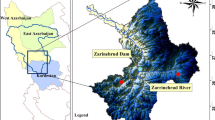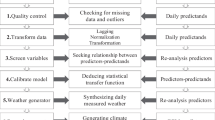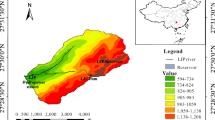Abstract
In this study, we proposed a new method to derive multi-purpose reservoir operation chart with the objectives of maximizing power generation and ecological conservation and minimizing ecological damage under future climate change. This double-parameter ecological operation chart (DEOC) was obtained by incorporating limited ecological curves into original conventional operation chart (COC) and then establishing and solving the operation optimization model considering both ecological profits and hydropower generation. Unlike COC where reservoirs are operated based on the current water level, reservoir operation under DEOC is based on both current reservoir water level and inflow. A case study was conducted in Jasajiang (JS) and Madushan (MDS) cascade reservoirs on the Yuan River in southwestern China. The monthly runoff data for the period 2021–2050 under RCP4.5 and RCP8.5 was simulated using the Soil and Water Assessment Tool (SWAT) driven by the General Circulation Models (GCMs), and the optimal ecological flow range calculated by PHABSIM for a given river section was used to determine the limited ecological curve. The operation optimization model considering both ecological profits and hydropower generation was established and solved to obtain DEOC. Compared with COC, DEOC results in a significant increase in power generation (>9%) and a reduction in ecological damage frequency without affecting the overall ecological conservation rate, especially at an ecological target of 70% and 80%, which can improve the adaptation of reservoir operation to climate change.







Similar content being viewed by others
References
Ahmadi M, Bozorg-Haddad O, Loaiciga HA (2015) Adaptive reservoir operation rules under climatic change. Water Resour Manag 29:1247–1266
Arnold JG, Srinivasan R, Muttiah RS, Williams JR (1998) Large area hydrologic modeling and assessment part I: model development1. JAWRA 34:73–89
Arnold J, Moriasi D, Gassman P, Abbaspour K, White M, Srinivasan R, Santhi C, Harmel R, Van Griensven A, Van Liew M (2012) SWAT: model use, calibration, and validation. Trans ASABE 55:1491–1508
Brekke LD, Maurer EP, Anderson JD, Dettinger MD, Townsley ES, Harrison A, Pruitt T (2009) Assessing reservoir operations risk under climate change. Water Resour Res 45
Ding Z, Fang G, Wen X, Tan Q, Huang X, Lei X, Tian Y, Quan J (2018) A novel operation chart for cascade hydropower system to alleviate ecological degradation in hydrological extremes. Ecol Model 2018:10–22
Eum HI, Simonovic SP (2010) Integrated reservoir management system for adaptation to climate change: the Nakdong River basin in Korea. Water Resour Manag 24:3397–3417
Fang G, Guo Y, Wen X, Fu X, Lei X, Tian Y, Wang T (2018) Multi-objective differential evolution-chaos shuffled frog leaping algorithm for water resources system optimization. Water Resour Manage 32:3835–3852
Gao C, Zhang Z, Chen S, Liu Q (2014) The high-resolution simulation of climate change model under RCP4.5 scenarios in the Huaihe River basin. Geogr Res 33:467–477
Guo Y, Fang, G, Wen X (2019) Hydrological responses and adaptive potential of cascaded reservoirs under climate change in Yuan River basin. Hydrol Res 50:358–378
Hietala HJ, Larson PA (1979) SYMAP analyses in archaeology: intrasite assumptions and a comparison with TREND analysis. Nor Archaeol Rev 12:57–64
Jiang Z, Ji C, Qin H, Feng Z (2018) Multi-stage progressive optimality algorithm and its application in energy storage operation chart optimization of cascade reservoirs. Energy 148:309–323
Larson RE, Korsak AJ (1970) A dynamic programming successive approximations technique with convergence proofs ☆. Automatica 6:245–252
Liu YY, Zhao JS, Zheng H (2018) Piecewise-linear hedging rules for reservoir operation with economic and ecologic objectives. Water 10,865
Neitsch SL, Arnold JG, Kiniry JR, Williams JR (2011) Soil and water assessment tool theoretical documentation version 2009. Texas Water Resources Institute. Available electronically from https://hdl.handle.net/1969.1/128050
Opan M (2010) Irrigation-energy management using a DPSA-based optimization model in the Ceyhan Basin of Turkey. J Hydrol 385:353–360
Prasanchum H, Kangrang A (2018) Optimal reservoir rule curves under climatic and land use changes for Lampao dam using genetic algorithm. KSCE J Civ Eng 22:351–364
Szemis JM, Maier HR, Dandy GC (2012) A framework for using ant colony optimization to schedule environmental flow management alternatives for rivers, wetlands, and floodplains. Water Resour Res 48
Tan Q, Lei X, Wen X, Fang G, Wang X, Wang C, Ji Y, Huang X, (2019) Two-stage stochastic optimal operation model for hydropower station based on the approximate utility function of the carryover stage. Energy 183:670-682
Tharme RE (2003) A global perspective on environmental flow assessment: emerging trends in the development and application of environmental flow methodologies for rivers. River Res Appl 19:397–441
Wang Y, Lei X, Wen X, Fang G, Tan Q, Tian Y, Wang C, Wang H (2019) Effects of damming and climatic change on the eco-hydrological system: a case study in the Yalong Riverr, Southwest China. Ecological Indicator 105:663-674
Wen X, Fang G-h, Guo Y-x, Zhou L (2016a) Adapting the operation of cascaded reservoirs on Yuan River for fish habitat conservation. Ecol Model 337:221–230
Wen X, Fang G, Qi H, Zhou L, Gao Y (2016b) Changes of temperature and precipitation extremes in China:past and future. Theor Appl Climatol 2016:369–383
Wen X, Liu ZH, Lei XH, Lin RJ, Fang GH, Tan QF, Wang C, Tian Y, Quan J (2018) Future changes in Yuan River ecohydrology: individual and cumulative impacts of climates change and cascade hydropower development on runoff and aquatic habitat quality. Sci Total Environ 633:1403–1417
Wilding TK, Bledsoe B, Poff NL, Sanderson J (2014) Predicting habitat response to flow using generalized habitat models for trout in ROCKY mountain streams. River Res Appl 30:805–824
Wood AW, Leung LR, Sridhar V, Lettenmaier DP (2004) Hydrologic implications of dynamical and statistical approaches to downscaling climate model outputs. Clim Chang 62:189–216
Xu W, Peng Y, Wang B (2013) Evaluation of optimization operation models for cascaded hydropower reservoirs to utilize medium range forecasting inflow. Science China Technol Sci 56:2540–2552
Xu B, Zhong P, Zambon RC, Zhao Y, Yeh WWG (2015) Scenario tree reduction in stochastic programming with recourse for hydropower operations. Water Resources Research 51 (8):6359–6380
Yang G, Guo SL, Li LP, Hong XJ, Wang L (2016) Multi-objective operating rules for Danjiangkou reservoir under climate change. Water Resour Manag 30:1183–1202
Yin XA, Yang ZF (2011) Development of a coupled reservoir operation and water diversion model: balancing human and environmental flow requirements. Ecol Model 222:224–231
Zhang W, Liu P, Chen X, Wang L, Ai X, Feng M, Liu D, Liu Y (2015) Optimal operation of multi-reservoir systems considering time-lags of flood routing. Water Resour Manag 30:523–540
Zhou Y, Guo S (2013) Incorporating ecological requirement into multipurpose reservoir operating rule curves for adaptation to climate change. J Hydrol 498:153–164
Acknowledgement
This research is funded by National Key R&D Program of China (2017YFC0405900), Postgraduate Research & Practice Innovation Program of Jiangsu Province (2018B628X14, KYCX18_0597), National Natural Science Foundation of China (U1765201), Major science and technology program of Water conservancy of Hunan Province([2016]194–21), Water conservancy science and technology program of Hunan Province([2015]245–13), the Priority Academic Program Development of Jiangsu Higher Education Institutions (PAPD).
Author information
Authors and Affiliations
Corresponding author
Ethics declarations
Conflict of Interest
None.
Additional information
Publisher’s Note
Springer Nature remains neutral with regard to jurisdictional claims in published maps and institutional affiliations.
Rights and permissions
About this article
Cite this article
Ding, Z., Fang, G., Wen, X. et al. Cascaded Hydropower Operation Chart Optimization Balancing Overall Ecological Benefits and Ecological Conservation in Hydrological Extremes Under Climate Change. Water Resour Manage 34, 1231–1246 (2020). https://doi.org/10.1007/s11269-020-02496-6
Received:
Accepted:
Published:
Issue Date:
DOI: https://doi.org/10.1007/s11269-020-02496-6




